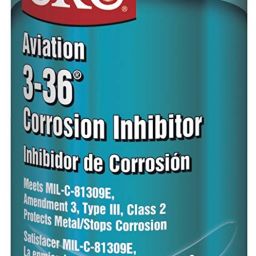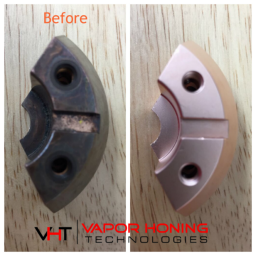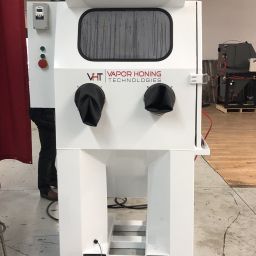What Blast Media Is Used for Wet Blasting?
A protective coating will only be as good as the preparation of the surface beneath.
Do you want your protective coats and paints to look and perform their best? It all starts with how you prepare the substrate’s surface.
Vapor blasting is one of the most efficient methods of preparing a surface of almost any material. The type of blast media and the blast compression force are the two main factors affecting the blasting process. Depending on the material you’re blasting, you’ll find some blast media will work much better than others.
The challenge many people and companies face is finding the right blast media to use for their projects, therefore, choosing the wrong abrasive will cost you valuable time and may damage the substrate you’re cleaning.
With so many types and sub-types of abrasives, it’s understandable how choosing the right one can be a confusing process. Fortunately, it doesn’t have to be. Here’s everything you need to know about the most common types of blast media used for wet blasting.
Wet Blasting Versus Dry Blasting
Wet blasting, also known as vapor blasting and vapor honing, is a method for removing old coatings, paint, and other contaminants from a surface. It’s similar to dry blasting as a compressor will force the abrasive media out and onto the surface of the material. The main difference is wet blasting mixes water with abrasive media.
When the abrasive media particles hit the blasting material, they may shatter. This happens in both dry and wet blasting processes. When the particles with a static charge shatter during dry blasting, they can cause sparks.
Adding water makes the process safer for both the blasting operator and the substrate. The water diffuses and eliminates the dust produced during the process. The water also adds mass to the particles, making them more effective at removing contaminants and coatings without damaging the underlying material.
Dry blasting is more aggressive than vapor blasting, which can cause unwanted damage to the substrate. The particles will ricochet at a sharper angle creating deeper valleys and textures in the underlying substrate.
The water used in vapor blasting acts as a cushion dispersing the particle ricochet. The water will push the particles across the surface to create a finer satin or polished texture. Despite the added cushion water provides, vapor blasting is equally effective and fast at removing coatings and contaminants.
Benefits and Uses of Wet Blasting
Why choose wet blasting over dry blasting?
Wet blasting offers many great pre-treatment advantages over other material cleaning and finishing methods. Here’s a closer look at how vapor blasting can help you with your next project.
Softer Finish
If you compare the finishes between wet and dry blasting, you’ll find wet blasting leaves a more uniform and softer finish. The advantage of this is the abrasive texture is even throughout the entire object. This will ensure better cleaning and improve the adhesion of the protective coating.
Less Dust
The water used in wet blasting dampens the abrasive media, while reducing the amount of dust up to 95%. The water and blast media mix in the machine hopper or sump to create a slurry. When the slurry injects into the airflow, the water encapsulates it and prevents it from spreading everywhere.
Less dust makes wet blasting a safer option for the blasting operator. While you should still wear proper PPE gear, less dust will make for a much safer work environment.
The water removes most electrical charges from the abrasive media which prevents sparks from occurring, minimizing the risk of fire.
Environmentally Friendly
Did you know wet blasting blasters use less water and less abrasive media? Many (but not all) abrasives are recyclable, meaning you can reuse any leftover and unused blast media.
Depending on the abrasive media used, wet blasting is safe for use around sensitive equipment or in a standalone blasting room.
Affordable
Less water, less abrasive media, and the option to reuse the media will save you money. The entire process of wet blasting will save money on material costs. Wet blasting consumes less media due to the water increasing the mass of the media particles and hydrostatic blast.
An All-In-One Step
Wet blasting is an all-in-one solution that cleans, strips, and finishes the substrate. Wet blasting can cut through and remove tough contaminants such as oil and grease without the need for solvents. Vapor blasting will strip away any existing coats and leaves a fine texture to ensure the adhesion of the new protective coating.
Improve Equipment Life
The effects of dry blasting will wear down your blasting equipment. Water helps lubricate the abrasive media preventing it from damaging the equipment. This will improve the life of the blasting nozzles, valves, and hoses by as much as 10 times longer than dry blast equipment.
Safe for Sensitive Materials
You can use a range of soft and hard blast media with wet blasting. Softer blasting materials, such as sodium bicarbonate, are tough enough to remove overlying contaminants but soft enough to avoid damaging the underlying substrate.
You can use wet blasting on materials such as:
- Metals
- Soft Metals
- Plastics
- Fiberglass
- Wood
- Glass
- PVC
Selecting the right abrasive media for your needs is important. Not only can it risk damaging the surface of the product, but the wrong grain can also leave the incorrect surface pattern. It can also increase the blasting time.
Each of these benefits has one thing in common, they’re only beneficial when using the proper blast media. So, how do you choose the right abrasive media for your next project?
Blast Media for Wet Blasting
Blast media or abrasive media are the small particles that break away contaminants, strip substrates, and leave a finished texture on the surface. Silica sand was one of the original blast media used in abrasive blasting. This is why so many people are familiar with the term “sandblasting.”
Today, there are many more types of blasting media for you to choose from. Not only are there different media materials but also different sizes, shapes, and levels of hardness to consider, too!
Blast Media Surface Characteristics
An important aspect of blast media that many often overlook is the media’s surface characteristics. These characteristics include size, hardness, shape, and density.
These characteristics will determine the level of abrasion, aggression, and finish on the surface of a substrate. The finished surface pattern is often referred to as the anchor pattern.
Size
Blast media comes in a range of sizes. Larger particles will leave deeper depressions but fewer impacts resulting in a rough finish. Smaller particles will leave shallower depressions but will have a greater number of impacts, creating a finer surface finish.
The size scale for blast media uses a mesh-based scale as a reference. The number refers to the number of mesh lines with smaller numbers referring to larger particles and smaller numbers referring to smaller particles.
Hardness
The hardness of abrasive media follows the Mohs Hardness Scale. The scale ranges from 0 to 10 with the higher numbers having a greater hardness. Harder particles will leave a deeper surface profile while softer particles will create a smoother surface.
Shapes
There are four main shapes of abrasive particles: angular, sub-angular, sub-rounded, and rounded. Angular particles, such as crushed glass, have a rough surface allowing them to cut through coatings and contaminants faster. They’ll create deeper anchor patterns on the substrate.
Rounded particles like glass beads have a smoother particle surface. They’re gentler and will leave a smoother anchor pattern. These are a good choice for creating an even and peened surface.
Other characteristics of the particles include density and velocity. Denser particles traveling at a higher velocity will leave a much deeper anchor pattern compared to less dense particles projecting at a lower velocity.
Common Types of Blast Media
For years, silica sand was the blast media of choice for wet and dry blasting. Researchers eventually found sand containing silica posed a hazardous threat to workers’ health and the environment.
Here are the most common types of blast media used today.
Garnet
Garnet is a type of gemstone used in abrasive blasting due to its natural abrasive properties. It’s a hard media that blasts through coatings and surface contaminants quickly and it also creates very little dust and is safe for both indoor and outdoor use.
Garnet comes in a range of sizes, all of which can remove the following, old paint, coatings, rust, and mill scale from hard metals. The coarser sizes are safe to use on aluminum, concrete, asphalt, and steel substrates. While the finer sizes are safe for those materials along with fiberglass, brick, and boat paint.
This blast media has a hardness of 7-7.5 Mohs and a sub-angular shape. It’s also one of the more expensive blast media available.
Mineral Sands
Mineral sands include minerals such as staurolite and olivine. Like garnet, these media are fast-cutting and produce very little dust. These abrasive media will effectively remove the following; weathered paint, old coatings, rust, and mill scale.
Mineral sands have a hardness level of 6-7.5 Mohs and are a larger size than garnet. They range from angular to sub-angular shapes and are more cost-effective than garnet.
Crushed Glass
This 100% recycled blast media offers a cleaner lighter finish. It’s a good option for blasting steel, aluminum, fiberglass, and boat paint.
Crushed glass has an angular shape allowing it to create a sharper profile. Its mesh size ranges from 30 to 400 and has a hardness of 5.5 to 7 Mohs. It costs less than mineral sands and garnet media.
Glass Beads
Glass bead media contains small rounded glass particles that leave a very fine and polished finish. They don’t have any sharp edges or angles which allows them to be a safer blast material for some sensitive materials.
Glass beads are a great all-around cleaner and is one of the best at polishing a surface. They’re safe for use on soft metals, iron, tile, and fiberglass. The hardness ranges from 5.5 to 6 Mohs and ranges from coarse to fine particles.
Coal Slag
Coal-burning power plants create a by-product known as coal slag. Rather than dumping this slag as waste, many are using it as a finer abrasive media. This angular abrasive is affordable and produces almost no dust and very low amounts of silica.
Coal slag ranges in mesh sizes of 12-80 with a hardness of 6 to 7.5 Mohs. It efficiently removes paint, old coatings, rust, and mill scale. It’s safe to use on harder materials such as steel and cast metals.
Plastic
Plastic is one of the softest blast media options available. It’s an angular particle with a hardness of 3-4 Mohs and a mesh size of 12 to 80.
Plastic blast media doesn’t leave any anchor pattern on the surface but will remove paint, coatings, and mold. It’s gentle enough to use on sensitive materials such as wood, brass, aluminum, plastics, and soft metals. It’s much safer than stripping surfaces with chemicals and more efficient than manual cleaning and stripping.
Aluminum Oxide
This is one of the most aggressive blast abrasives you can find. It works fast and offers unparalleled strength.
Aluminum oxide has an angular shape and an impressive hardness level of 8 to 9 Mohs. Sizes range from very fine to very coarse, depending on your blast media needs.
Aluminum oxide is best for hard metals and surfaces but light enough to not damage thin materials. This is a great option for removing tough paint, cleaning, finishing, grinding, and edge rounding of surfaces. Aluminum oxide is a recyclable and affordable material perfect for the toughest projects.
Other Blast Media
The list of blast media used in wet blasting and other high-pressured systems extends beyond this list. Other media worth checking out include ceramic bead, silicone carbide, and sodium bicarbonate.
Choose the Right Blast Media for Your Next Project
When choosing a blast media for your blasting project, you should always err on the side of caution and choose a softer medium.
Harder particles can cause unwanted etching or damage the underlying substrate. If you decide you need stronger abrasive media, you can switch to a harder option without damaging your product.
Do you have questions or want to get started on your next big project? Let us know! We’re here to help you with all your vapor honing needs.








